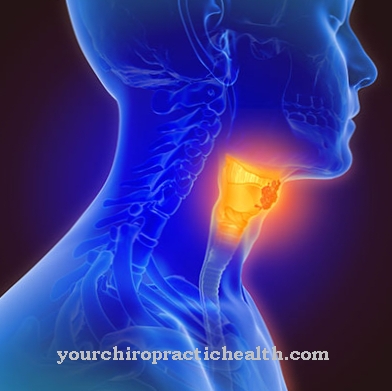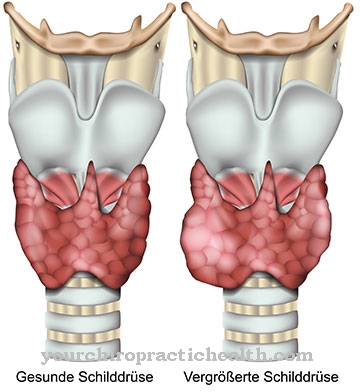In the Histiocytosis X it is a histiocytosis. The so-called Langerhans cells, which belong to the dendritic cells, are affected. As a rule, the disease is benign, although some severe forms with a fatal outcome are possible, especially in young children.
What is histiocytosis X?

© artem_goncharov - stock.adobe.com
The Histiocytosis X is a tumor-like disease in which the Langerhans cells multiply in the form of granulomas. Langerhans cells must not be confused with the islets of Langerhans in the pancreas or the Langhans cells. They are dendritic cells that have cytoplasmic extensions and therefore sometimes look star-shaped.
The cytoplasmic runners are used to search for antigens, which they then present to the T lymphocytes. In addition to presenting antigens, the mature Langerhans cells also stimulate the T lymphocytes, among other things. The Langerhans cells come from the bone marrow and are part of the skin and mucous membranes. Besides the macrophages, the monocytes and the B-lymphocytes, their main function is to present antigens and to stimulate the T-lymphocytes.
When they multiply in a granulomatous manner, histiocytosis forms. The so-called Birbeck granules appear in the electron microscope as X-bodies. This is where the name histiocytosis X comes from. The disease occurs in three different forms and mostly affects children and adolescents.
However, it is assumed that the disease often takes a particularly noticeable course in children. A considerable number of unreported cases is likely in adults. Histiocytosis X is diagnosed with a frequency of 1: 200,000 to 1: 2,000,000, especially in children.
causes
The causes of histiocytosis X are not yet known. It occurs on lesions on the skin or mucous membranes. An abnormal immune response is assumed. The disease is not a malignant tumor. The course is usually benign. However, fatal courses occur in small children with a particularly aggressive course. It is a non-hereditary and non-contagious reactive disease.
Symptoms, ailments & signs
Histiocytosis X is a disease whose course cannot be predicted. Each affected person is an individual case. In principle, the disease is benign. However, it can also take a very vicious course. The granulomas are usually located in individual foci, although there are also forms in which many organ systems are affected at the same time.
There are three forms of the disease:
- The most common form is eosinophilic granuloma, with a frequency of 70 percent of cases. The eosinophilic granuloma mainly occurs between the ages of 5 and 20.
- Hand-Schüller-Christian granulomatosis mostly affects children between the ages of three and five years and Abt-Letterer-Siwe granulomatosis affects children between the ages of one and three years. The last two forms of histiocytosis X mentioned are often fatal.
- The Abt-Letterer-Siwe syndrome is the most severe form of the disease. Its frequency is only about ten percent.
Young children experience fever, severe eczema, lymph node infiltration, anorexia, infiltration of the spleen and liver, anemia, a tendency to bleed, increased susceptibility to infections and lung problems. If left untreated, the disease is 90 percent fatal. Hand-Schüller-Christian syndrome is also a serious disease that is often fatal.
At around 20 percent, it is the second most common form of histiocytosis X. The affected children between the ages of two and five suffer from skeletal changes in the skull, ribs or pelvis, strabismus (squinting), loss of vision, loss of teeth with infiltration of the gums, chronic Ear infections, hormonal disorders with pituitary infiltration and possibly with systemic infestation involving the lungs, spleen, liver, skin and lymph nodes.
In addition to unfavorable courses, spontaneous healing also occurs. By far the most common form of histiocytosis X, eosinophilic granuloma, is usually benign and is characterized by painful tumors in the bones. Tumors in the stomach, on the skin and in the lungs can also occur. All tumors can regress spontaneously. Otherwise treatment with excision, radiation and chemotherapy is very promising.
Diagnosis & course of disease
To diagnose histiocytosis X, dividing histiocytes in the skin are histopathologically detected. The Langerhans granules can be made visible with an electron microscope. However, the exact diagnosis can only be achieved by MRI or CT examinations and by biopsy of the affected organs.
Complications
In the worst case, histiocytosis X can lead to death of the patient. Children in particular are affected by the fatal outcome of the disease, which is why they need immediate treatment. If no treatment is initiated, histiocytosis X will also lead to a fatal outcome.
The patients suffer from a reactive high fever and anemia. There is also a weakened immune system and thus an increased susceptibility to infection. Those affected get sick more often and also suffer from lung problems. The liver and spleen can also be damaged by the disease. It is not uncommon for children to suffer complete vision loss and hearing damage from histiocytosis X.
The patient's everyday life is extremely restricted by these complaints and the quality of life is reduced enormously. The treatment of histiocytosis X is always based on the symptoms and complaints. It is therefore not possible to predict directly whether this will lead to complications. In most cases, however, surgical interventions are necessary to eliminate the symptoms. Life expectancy may also be reduced by histiocytosis X.
When should you go to the doctor?
If the child complains of pain in the body for several hours or days for no apparent reason, a doctor should be consulted to clarify the causes. If swelling of the bones or skull occurs without a previous fall or accident, these are warnings that must be followed up. If the swelling increases, a doctor must be consulted as soon as possible so that the causes can be determined. Since histiocytosis X can be fatal in severe cases, the child should be presented to a doctor as early as possible. If you have a fever or difficulty breathing, you need to see a doctor.
If there is an unusually high bleeding tendency in small injuries, there is cause for concern. If abnormalities in the skeletal system can be noticed during stretching movements, the observations should be discussed with a doctor. A doctor is required in the event of impaired vision, problems or inflammation of the hearing organ or skin changes. If there are irregularities in the digestion, abnormal behavior of the child or dental problems, a doctor should be consulted for further examinations. Symptoms of the spleen, stomach, or lungs are unusual and should be investigated and treated. Although histiocytosis X can heal spontaneously, a visit to a doctor is also advisable if the symptoms are alleviated.
Doctors & therapists in your area
Therapy & Treatment
The treatment of histiocytosis X depends on the individual course of the disease. Some patients do not need any therapy because their symptoms resolve on their own. However, other patients cannot cure without treatment. Local foci can be surgically removed and subsequently treated with radiation therapy and local cortisone. Usually, however, a mild chemotherapy is followed after an operation and radiation treatment in order to avoid long-term effects.
Serious and extensive forms of the disease are often successfully treated with chemotherapy. Corticoids, interferon alpha and cytostatics are administered as drugs. In the case of Abt-Letterer-Siwe syndrome, a stem cell transplant may have to be carried out in addition to aggressive chemotherapy. Intensive chemotherapy is also often required in the Hand-Schüller-Christian syndrome, which sometimes even leads to spontaneous healing.
You can find your medication here
➔ Medicines for painOutlook & forecast
The prognosis of histiocytosis X depends on the particular course. There are three forms of the disease such as eosinophilic granuloma, Abt-Letterer-Siwe syndrome and Hand-Schüller-Christian syndrome. However, these cannot be viewed separately from one another. The individual manifestations are an expression of the same disease with a different course.
Eosinophilic granuloma has the most favorable prognosis. It affects children and adolescents between the ages of 5 and 20 years and is characterized by a local course with multifocal herds. At around 70 percent, eosinophilic granuloma is by far the most common form of histiocytosis X. The disease can often regress completely without treatment. In some cases, however, surgical interventions and radiation are necessary.
The Abt-Letterer-Siwe syndrome represents the most severe form of histiocytosis X with around 10 percent of all cases. The syndrome mainly affects small children up to two years of age. In up to 90 percent of all cases, the Abt-Letterer-Siwe syndrome is quickly fatal. There is only a chance of survival with intensive chemotherapy, which may have to be supplemented with stem cell therapy.
The so-called Hand-Schüller-Christian syndrome occurs in around 5 to 40 percent of cases. It mostly affects younger children up to five years of age. Often this form of the disease also heals spontaneously. However, around 30 percent of those affected have a very poor prognosis due to systemic involvement of several organs.
prevention
Measures to prevent histiocytosis X cannot yet be recommended because the causes of the disease are not known. In addition, most diseases occur in early childhood. Mild forms in adulthood may be so inconspicuous that there must be a larger number of unreported cases.
Aftercare
In the case of histiocytosis X, the person concerned is usually first dependent on a comprehensive examination and diagnosis by a doctor. This is the only way to prevent further complications or complaints. Therefore, with histiocytosis X, the early detection and treatment of the disease is in the foreground in order to avoid further worsening of the symptoms.
Self-healing cannot occur, with the person affected having very few measures or options for aftercare available. In the worst case, the disease can lead to death if left untreated. The treatment of this disease is mostly done by taking medication.
The person concerned is also dependent on correct and, above all, regular intake in order to permanently alleviate the symptoms and prevent further deterioration. Parents should ensure that the medication is taken correctly, especially with children.
Since the disease can also lead to the formation of tumors, regular examinations by a doctor are very useful. In very rare cases, histiocytosis X can also heal spontaneously. However, in most cases the life expectancy of those affected is reduced by this disease.
You can do that yourself
Histiocytosis X does not have to be treated in every case. In some patients, the symptoms resolve on their own. However, there are only very limited opportunities for those affected to help themselves with this disease.
Since many sufferers are dependent on chemotherapy, they need strong support during this therapy. This should be done primarily by the family and parents. Those affected can also be accompanied during their meetings. Furthermore, discussions with a therapist or a psychologist can prevent psychological complaints and depression. Of course, discussions with other affected patients are also suitable here. Direct prevention of the disease is not possible.
Since those affected by histiocytosis X suffer from a high fever and an increased tendency to bleed, they should take care of their bodies and not perform strenuous activities. Any kind of sport should also be avoided to prevent injuries. During surgical interventions, the doctor must be made aware of the high bleeding tendency in order to avoid complications. Due to the high susceptibility to infections and inflammation, increased hygiene measures are necessary in order to also successfully avoid these.

.jpg)
.jpg)
























